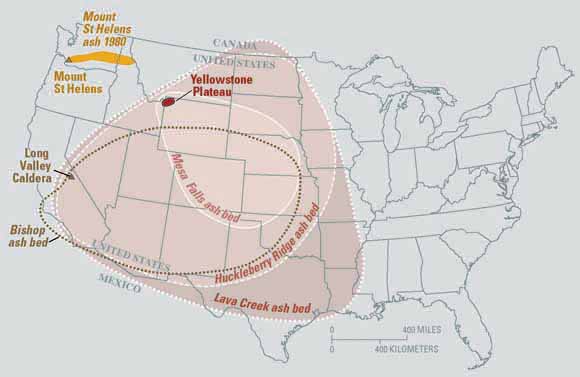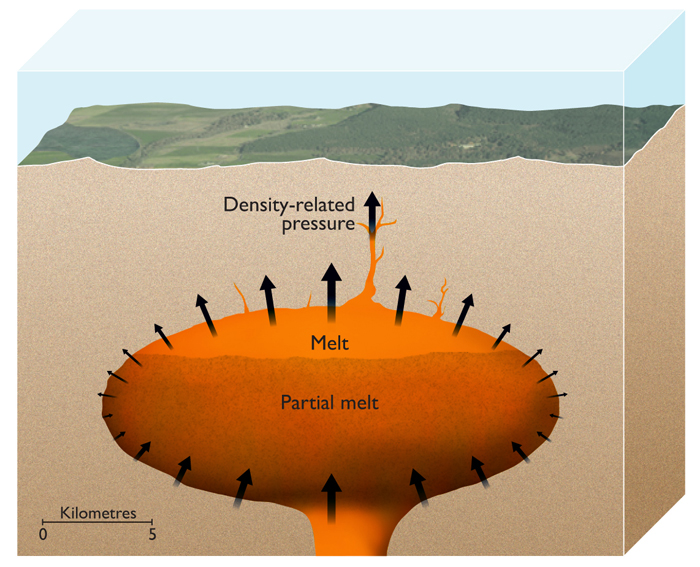
Magma's Balloon-Like Buoyancy Drives Super-Eruptions

The most powerful volcanic eruptions on Earth may be caused by the way molten rock buoys up through the ground, like a balloon floats upward in water, researchers say in a new study.
The study, detailed online Jan. 5 in the journal Nature Geoscience, also reveals that the largest super-eruption on Earth could be thousands of times larger than anything in recorded history.
Supervolcanoes are capable of eruptions far larger than anything in recorded human history, spewing thousands of times more magma and ash than even Mount St. Helens did in 1980, leaving behind giant craters known as calderas up to 60 miles (100 kilometers) wide. Twenty or so supervolcanoes exist today, including well-known examples beneath Yellowstone National Park in the United States and at Lake Toba in Indonesia.
No supervolcano has been active since the earliest human records began. Although this has certainly been beneficial for humanity, it also means that much remains unknown about these massive eruptions, such as how they are triggered.
Conventional volcanoes are known to erupt after pressure builds up from new magma flowing into the magma chambers that sit below the vents on the planet's surface.
"It's kind of like blowing a lot of air into a small balloon — it can explode if you fill it up with too much air too fast," said volcanologist Luca Caricchi, of the University of Geneva in Switzerland.
However, this kind of trigger doesn't work for supervolcanoes, whose magma chambers can be up to about 60 miles wide and several miles thick. Magma cannot fill these chambers fast enough to generate enough pressure for an eruption, at least not before the magma cools and hardens too much for an explosion, Caricchi and his colleagues say. [Countdown: History's Most Destructive Volcanoes]
Get the world’s most fascinating discoveries delivered straight to your inbox.
"It's like trying to fill a big balloon — it's much more difficult to make it explode," Caricchi told LiveScience's OurAmazingPlanet. "You need another mechanism for super-eruptions to occur."
Buoyant balloon
To find out more about what makes supervolcanoes erupt, Caricchi and his colleagues performed more than 1.2 million computer simulations to investigate what conditions are needed for volcanic eruptions of varying sizes to occur.
Independently, experimental geochemist Wim Malfait, of the Swiss Laboratories for Materials Science and Technology, and his colleagues performed lab experiments that artificially generated magma under the same extreme temperatures and pressures naturally found inside a supervolcano. They analyzed the density of this magma using the most brilliant X-ray beams in the world at the European Synchrotron Radiation Facility in Grenoble, France.
The lab experiments from Malfait and his collaborators and computer models from Caricchi and his colleagues both discovered super-eruptions could occur due to magma's buoyancy. Molten rock in the Earth's crust is buoyant since it is hotter and less dense than the solid rock surrounding it.
"The pressure given off by the buoyancy of magma is the same pressure you can feel when you keep a balloon underwater," Caricchi said. "Because the magma is less dense than its surroundings, it has a natural tendency to rise to the surface, generating a pressure that eventually leads to super-eruptions."
The pressure this buoyant magma places on the walls of a supervolcano's magma chamber as it is added over thousands and even millions of years can eventually cause the roof of the magma chamber to collapse, triggering a giant eruption.
"Volcanic releases larger than about 500 cubic km [120 cubic miles] of magma are triggered mainly by buoyancy," Caricchi said.
This research also suggests the greatest amount of magma a supervolcano on Earth could accumulate within itself before erupting "is about 35,000 cubic km [8,400 cubic miles] of material," Caricchi said. "That's a lot of magma."
In comparison, the 1980 and 1991 eruptions at Mount St. Helens and Mount Pinatubo in the Philippines ejected on the order of 0.24 cubic miles (1 cubic km) and 2.4 cubic miles (10 cubic km) of matter, respectively.
As big as it can get
Still, "during super-eruptions, the entire amount isn't erupted — only a relatively small percentage, something like 10 to 20 percent," Caricchi said. "That means the largest physically possible eruption on Earth is likely about 960 to 1,920 cubic miles [4,000 to 8,000 cubic km] large."
"By knowing how big eruptions on Earth can get, that gives us a better idea of how super-eruptions vary in size on Earth and what the frequency of eruptions of different sizes might be," Caricchi added.
Other research groups have suggested that molten rock in a super-volcano's magma chamber might heat the crust above it until that rock fractured, triggering a super-eruption.
"However, for this mechanism to be efficient, you need not only heat in the magma chamber, but pressure, and to generate pressure in the large chambers supervolcanoes have, buoyancy helps," Caricchi said. "So we think buoyancy plays the major role in super-eruptions."
Malfait said that super-eruptions are very rare, happening about every 100,000 years, "so they are not something to worry about," he said. "On the other hand, it seems quite certain that one will happen sometime in the distant future and humanity will have to deal with it. At the moment we cannot predict and certainly not prevent or mitigate them, but we have time — there is no urgency there."
Follow OurAmazingPlanet @OAPlanet, Facebook and Google+. Original article at LiveScience's OurAmazingPlanet.

 Live Science Plus
Live Science Plus






